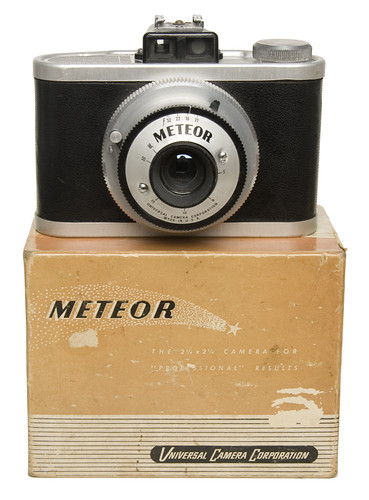Difference between revisions of "Universal Meteor"
(larger photo, two glossary wiki-links) |
(additional photo; firmed up references & links; removed some wrongly pasted text; better link format) |
||
| Line 7: | Line 7: | ||
| image_rights=non-commercial | | image_rights=non-commercial | ||
}} | }} | ||
| − | + | The '''Universal Meteor''' is a [[620 film]] camera produced by the [[Universal|Universal Camera Corporation]] in New York City, NY. While McKeown's dates it as circa 1949<REF>{{McKeown12}} Page 939.</REF>, it was definitely being advertised, for a price of $15, as early as 1947<REF>''Popular Photography'' magazine, December 1947 (Volume 21, no. 6), page 130.</ref>. The plumply streamlined body has a pull-out lens tube with a coated lens, which can be [[guess focus]]ed from infinity to 5 feet. The self-resetting shutter offers "instant" and "bulb" speeds, selected with the I /B lever atop the lens barrel. | |
| − | The camera has four apertures of f/11, f/16, f/22 and f/32; it uses an [[Light_meter#Extinction_Meters|extinction meter]], and has a table on a metal plate affixed to the top to show four Weston film speeds of 25, 50, 100 and 200. | + | The camera has four apertures of f/11, f/16, f/22 and f/32; it uses an [[Light_meter#Extinction_Meters|extinction meter]], and has a table on a metal plate affixed to the top to show four Weston film speeds of 25, 50, 100 and 200. A photographer today may find the [[sunny 16]] rule to be more reliable. The camera back does not open, but instead a loading chamber drops out from the bottom. The camera exposes 2¼" square images (6×6 cm). It can be used with 120 film re-spooled onto 620 spindles. |
| + | |||
| + | ==Notes== | ||
| + | <references/> | ||
| − | |||
===Links=== | ===Links=== | ||
| − | * [http://www.mrmartinweb.com/medium.html] | + | * [http://www.mrmartinweb.com/medium.html Universal Meteor] (scroll down) among Medium Format models at "Mr. Martin's Website" [http://www.mrmartinweb.com/camera.html Camera Museum] |
| − | [[ | + | *[http://www.butkus.org/chinon/meteor/meteor.htm Meteor manual] at Mike Butkus' [http://www.butkus.org/chinon/ OrphanCameras.com] |
| + | |||
| + | {{Flickr_image | ||
| + | |image_source= http://www.flickr.com/photos/ricksoloway/2265666636/in/pool-camerawiki | ||
| + | |image= http://farm3.static.flickr.com/2092/2265666636_f2fe42d6bc.jpg | ||
| + | |image_align= left | ||
| + | |image_text= With original box | ||
| + | |image_by= Rick Soloway | ||
| + | |image_rights= with permission | ||
| + | }} | ||
| + | |||
[[Category:Universal]] | [[Category:Universal]] | ||
[[Category:620 film]] | [[Category:620 film]] | ||
[[Category:USA]] | [[Category:USA]] | ||
[[Category:U]] | [[Category:U]] | ||
Revision as of 15:25, 20 July 2011

|
| Universal Meteor image by Andrea Wiggins (Image rights) |
The Universal Meteor is a 620 film camera produced by the Universal Camera Corporation in New York City, NY. While McKeown's dates it as circa 1949[1], it was definitely being advertised, for a price of $15, as early as 1947[2]. The plumply streamlined body has a pull-out lens tube with a coated lens, which can be guess focused from infinity to 5 feet. The self-resetting shutter offers "instant" and "bulb" speeds, selected with the I /B lever atop the lens barrel.
The camera has four apertures of f/11, f/16, f/22 and f/32; it uses an extinction meter, and has a table on a metal plate affixed to the top to show four Weston film speeds of 25, 50, 100 and 200. A photographer today may find the sunny 16 rule to be more reliable. The camera back does not open, but instead a loading chamber drops out from the bottom. The camera exposes 2¼" square images (6×6 cm). It can be used with 120 film re-spooled onto 620 spindles.
Notes
- ↑ McKeown, James M. and Joan C. McKeown's Price Guide to Antique and Classic Cameras, 12th Edition, 2005-2006. USA, Centennial Photo Service, 2004. ISBN 0-931838-40-1 (hardcover). ISBN 0-931838-41-X (softcover). Page 939.
- ↑ Popular Photography magazine, December 1947 (Volume 21, no. 6), page 130.
Links
- Universal Meteor (scroll down) among Medium Format models at "Mr. Martin's Website" Camera Museum
- Meteor manual at Mike Butkus' OrphanCameras.com

|
| With original box image by Rick Soloway (Image rights) |